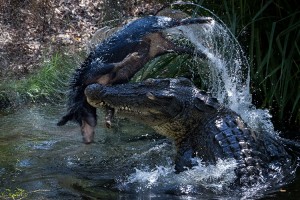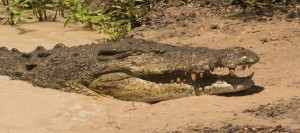The Saltwater Crocodile’s Piggy Bank Piggyback
Monday, August 22nd, 2022
A saltwater crocodile attacks a feral pig in Australia
Credit: © Adam Britton, Media Drum World/Alamy Images
Normally invasive species get a bad reputation. They take over ecosystems, reproducing unchecked by predators and eating the native species’ food. The cane toad, native to Central and South America, has dominated regions of Australia, the Caribbean Islands, Florida, Hawaii, Japan, New Guinea, and the Philippines. Zebra mussels hopped aboard a ship in the Caspian Sea and have since clogged up the Great Lakes in the United States. Asian tiger mosquitoes, Burmese pythons, stink bugs, and Japanese beetles also wreak havoc in their new neighborhoods. However, in Australia, there is a plot twist in the invasive species narrative.
The feral pig was taking over Australia beating out livestock for food, damaging fences and water sources, and eating crops before harvest. The pigs were brought by European settlers in the late 1700’s. They soon took over and bred throughout the country. Scientists were beginning to worry the feral pigs would put the ecosystems past the brink of return. Then, the saltwater crocodile stepped in.
The saltwater crocodile is the largest living reptile and one of the most fearsome predators on Earth. Adults can reach lengths of 23 feet (7 meters) and weighs of over 1 ton (0.9 metric tons). The saltwater crocodile has a long, low, sausage-shaped body; short legs; and a long, powerful tail, which it uses to swim. It also has a tough hide, a long snout, and sharp teeth to grasp its prey. Saltwater crocodiles have lived on the coasts of northern Australia and Southeast Asia, and on the islands between for millions of years. The saltwater crocodile is also called the estuarine crocodile and the Indo-Pacific crocodile. In Australia, it is informally called the “saltie.”
A saltwater crocodile’s diet depends greatly on its age and size. Young individuals eat crustaceans, insects, rats, and small fish. As saltwater crocodiles grow, they take increasingly larger prey, including sharks and water buffalo. Large adults may attack humans if an opportunity presents itself. The crocodile has had a menu change in recent years, giving a new meaning to the term “piggy bank.” They have recently taken to feral pigs, snatching them up when they go to the water to drink. Pork is on the menu and seems to be a permanent a-la-carte item.
Adult saltwater crocodiles have one of the strongest bites in the animal kingdom. They can close their jaws with approximately 3,700 pounds per square inch of force. In contrast, human bite force is only about 200 pounds per square inch. Those pigs do not stand a chance if the crocodiles hit the mark on the first bite!
Because they present a danger to humans, saltwater crocodiles are sometimes feared and hated by people. In northern Australia, they were hunted almost to extinction before a 1970 hunting ban enabled populations to recover. Like most other crocodiles, saltwater crocodiles are threatened by hunting, invasive species, habitat loss, and pollution. Governments across the saltwater crocodile’s range work to educate people on how to avoid attacks. Scientists in Australia studied the carbon and nitrogen isotopes in bone samples of crocodiles comparing today’s crocodiles to those from almost one hundred years ago. The study found that feral pigs had become the primary food source in the last 50 years. This finding reveals that although crocodiles used to mainly eat aquatic prey, they have adapted to eat mostly prey that lives on land! The crocodiles seem to be making a comeback with their new diet. This invasive species helped out an endangered species! You will be here for a while, crocodile!



